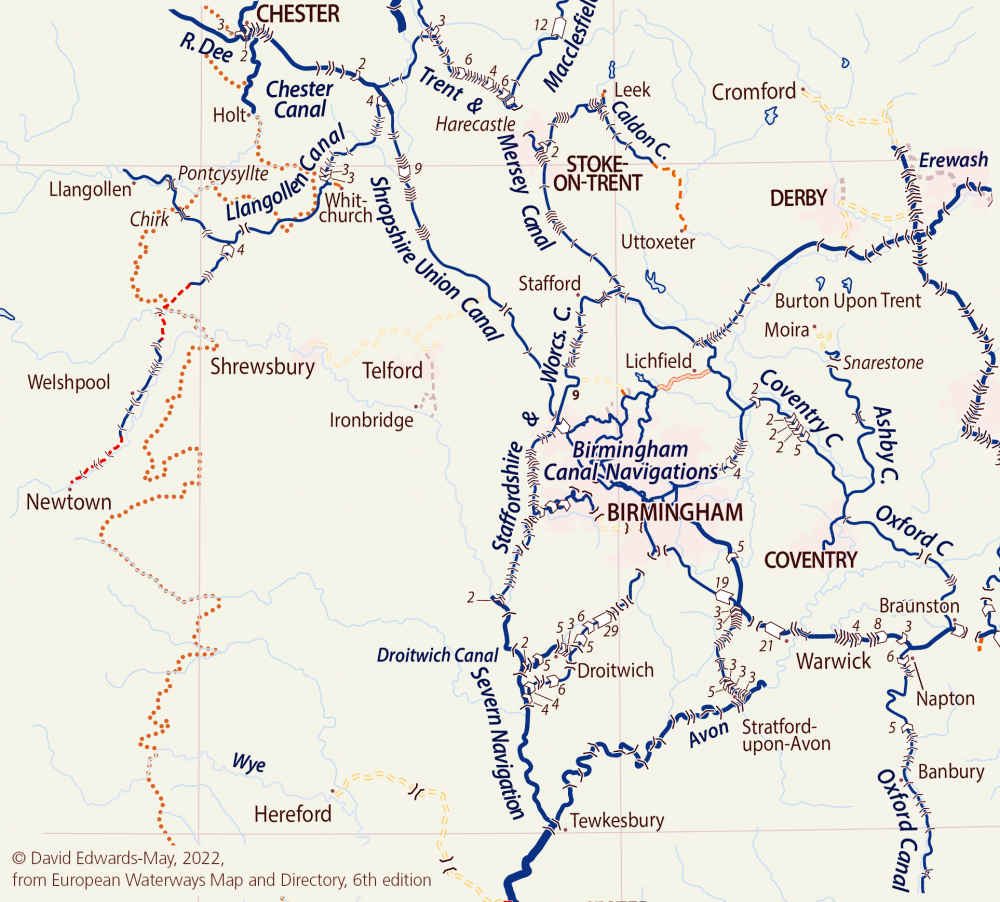West Midlands canals map (click to open)
Staffordshire and Worcestershire Canal
- Boat length : 70’ or 21.34
- Boat width : 7’ or 2.13m
- Draft : 3’3” or 0.99m
- Headroom : 6’ or 1.82m
Fondly known as the Staffs and Worcs, the canal skirts Birmingham, passing through the rolling countryside of middle England. Don’t get too seduced by the beauty of the landscape, this canal is hard work with 43 locks over its 46 metre length and it forms part of two cruising rings so there is plenty of opportunity to extend your exploration of the region should you want to. The canal connects to the River Severn at Stourport basins in the South and in a northerly direction it passes through Cannock Chase before linking with the Trent and Mersey.
The pleasures along this stretch of the English network derive from immersing yourself in the delights of the countryside – the wildlife, the wild flowers, the peace and quiet. There are things to see and do: Stourport is an inland port more than 250 years old and has more charm than is good for it, while Bratch Locks will provide the navigational highlight of your trip. Originally engineered as a three flight staircase, they have been modified and are now three separate locks with a pumping house and an extremely attractive tollhouse.
Worcestershire and Birmingham Canal
- Boat length : 72’ or 21.95m
- Boat width : 7’ or 2.13me
- Draft : 3’3” or 1m
- Headroom : 7.6 or 2.3m
Bookended by two fabulous but very different cities, this canal begins in the vibrant and diverse heart of Birmingham, then passes through meltingly pretty countryside to the cathedral city of Worcester. Gas Street Basin is a great start to the journey, with plenty of retail therapy, bars and restaurants on hand and if you have time for a detour, at Kings Norton you will pass the junction with the Stratford on Avon canal. Rest up while you can. There are 58 locks concentrated in the southern end of the Worcestershire and Birmingham and 30 of them combine over a 2 mile stretch to form the longest staircase in the entire network, at Tardebigge. You will have earned your pint by the end of the day. You can continue straight on to Worcester and marvel at the beauty of the cathedral, or there are opportunities to branch off either to the Droitwich barge canal, or to the River Severn via Hanbury. This well connected waterway is part of both the Avon and the Severn cruising rings.
If you are looking for things to do as you go along, try Cadbury World, an irresistible attraction built in the remains of the old Bournville factory in the outskirts of Birmingham. In fact, the canal was constructed to transport raw materials to this very site. Even if you don’t have kids along with you, it’s guaranteed to bring out your inner child.
Birmingham to Fazeley Canal
- Boat length : 70’ or 21.34m
- Boat width : 7’ or 2.13m
- Draft : 3’3” or 1m
- Headroom: 7.6 or 2.13m
The Birmingham and Fazeley canal is a brilliant way to discover central Birmingham as it meanders past many of the city’s principle landmarks, including its starting point at Gas Street Basin and the iconic Post Office tower. The opening stretch is labyrinthine, wending through tunnels and undercrofts, although a highlight of the early section is without doubt the Farmers Bridge lock flight, which consists of 13 locks with a tollbooth located next to the first one, where Victorian bargees would be obliged to pay a fee based on the weight of the load they were carrying. One of the most distinctive experiences you will encounter on this canal is the chance to moor at Salford Junction, which is directly under Spaghetti Junction, one of the most complicated motorway interchanges in the country – hence its name. The canal opened in 1789 after much infighting between local industrial grandees and at 15 miles long it plays a vital part in the Birmingham Canals Navigation.
For theatre fans, a visit to the world-renowned Birmingham Rep is a must. It is one of Britain’s foremost regional theatres and kickstarted the careers of many theatrical greats, such as Laurence Olivier, Derek Jacob, Julie Christie and Patricia Routledge, to name but a few. If you want something other than boating clothes to wear, try the Mailbox, Birmingham’s high end shopping centre, home to Harvey Nichols and many other irresistible shops.
Gloucester to Sharpness Canal
- Boat length : 210’ or 60m
- Boat width : 31’5” or 9.6m
- Draft 11’6” or 3.5m
Work was begun at the turn of the 19th century on what was to become England’s first ship canal. The scale of the project was considerable as it was built to accommodate boats of 210’ or 60m long. Industrialists in the Midlands hoped that with the construction of the canal, Gloucester would become a port to rival Bristol and, if nothing else, it would bypass a section of the River Severn which was treacherous to navigation. The early phase of the building work was bedevilled by squabbling, but the legendary engineer Thomas Telford was brought in as a consultant in 1816 and after that things progressed smoothly. The waterway was busy until the 1960s, latterly with boats carrying oil and petroleum, but the emphasis at Sharpness has switched from exports to imports, so that although the docks remained busy, the canal is less frequently used.
There are beautiful walks to be had along the route. Heading north from Sharpness you pass by the hulks of old barges which have been left to rot in the sands on the shores of the estuary, a truly haunting sight. Slimbridge Wetland Centre is worth a visit – it’s a stunning nature reserve and bird sanctuary set up by Sir Peter Scott who was founder of the Royal Society for the Protection of Birds. Once you reach Gloucester, the National Waterways Museum, which is housed in one of the old bonded warehouses in the docks, is a must for any boat lovers.
Hereford and Gloucester Canal
The canal was a fully functioning waterway between its inception in 1798 and – sadly – its demise in 1881. The waterway sowed the seeds of its own destruction by carrying material to build railways during the mid 1880s and in 1862 it was leased to GWR with a view to being turned into part of the railway network itself. In recent years it has undergone a restoration programme by a band of dedicated volunteers working under the aegis of the Hereford and Gloucester Canal Trust and while stretches have shown considerable improvement, it is not ready for navigation yet, although hopes remain high that one day it will be…
Shropshire Union Canal
- Boat length : 72’ or 21.34m
- Boat width : 7’ or 2.13m
- Draft : 3’6” or 1.1m
- Headroom : 8’ or 2.44m
The waterways equivalent of a rural retreat, the Shropshire Union canal winds peacefully through 66 miles of beautiful countryside and you can go for many hours without seeing signs of civilisation (although you will have 47 locks to contend with, so stay sharp!) Starting north of Wolverhampton it was an important artery which served Ellesmere Port in the north. It was built in three phases, beginning in the 1770s with the Chester canal, then in the mid 1790s the Ellesmere canal was added and finally in 1883 the Middlewich canal came into being. In 1840 these three individual waterways were merged with the Llangollen and Monmouth canals to create the Shropshire Union, or the Shroppie as it is affectionately known.
Nowadays it is the perfect place for towpath walks or bike rides, and it is not uncommon to spot kingfishers and herons as you cruise along. If you hanker for bright lights, make time to stop at Chester, a fascinating city to visit on account of its ancient Roman origins – there’s a Roman Amphitheatre and a mediaeval cathedral to visit, or simply wandering through the cobbled streets of the centre and soaking up the atmosphere is a treat in itself.
Stratford upon Avon Canal
- Boat length : 72’ or 21.95m
- Boat width : 7’ or 2.13m
- Draft : 3’3” or 1m
- Headroom : 6’ or 1.83m
Heading out from Birmingham, you enter the Stratford upon Avon canal at Kings Norton via a guillotine lock, a suitably dramatic entrance to a waterway which ends at the birthplace of England’s most famous dramatist, William Shakespeare. At 25 miles long and containing 54 locks, this is a waterway to keep you busy, but it is worth all the hard work.
On your way south out of Birmingham you might like to bear in mind that you will be passing close to the city’s legendary curry mile, where the Balti was first invented. Why not moor up and do some quality control to make sure that standards have been maintained since the 1980s when this dish was first served up to a rapturous public? As you get closer to Stratford, look out for the split bridges, which were built with a small gap in order to allow the narrow boats’ tow ropes to pass through, back in the days when they were pulled by horses and had no engines. The canal was constructed between 1796 and 1816 to carry coal but as demand for this petered out it fell into disrepair. All might have been lost, but the National Trust came to the rescue and a team of volunteers, army personnel and even prisoners completed an ambitious restoration project and the southern section was reopened by the Queen Mother in 1962. In 1988 It was placed in the safe hands of the Canal and Waterways Trust who reunited it with the Northern Stratford to form part of the Avon cruising circle.
You don’t really need us to tell you that when you reach Stratford the only thing to do is to go to the Royal Shakespeare Theatre and see one of the bard’s plays performed by some of the finest actors in the land, who are capable of making the language seem as contemporary as if it were written yesterday. If you are a sucker for sightseeing head off to Shakespeare’s Birthplace in Henley St and if you fancy a slightly longer stroll, the home of his wife Anne Hathaway is at Shottery just on the edge of town.
British-Irish waterway regions – Northern | East Midlands | West Midlands | Welsh | Southern | Scottish | Irish
French waterway regions – North | North-East | North-Central | West | Centre | South-East | South | South-West

